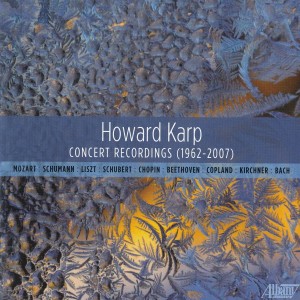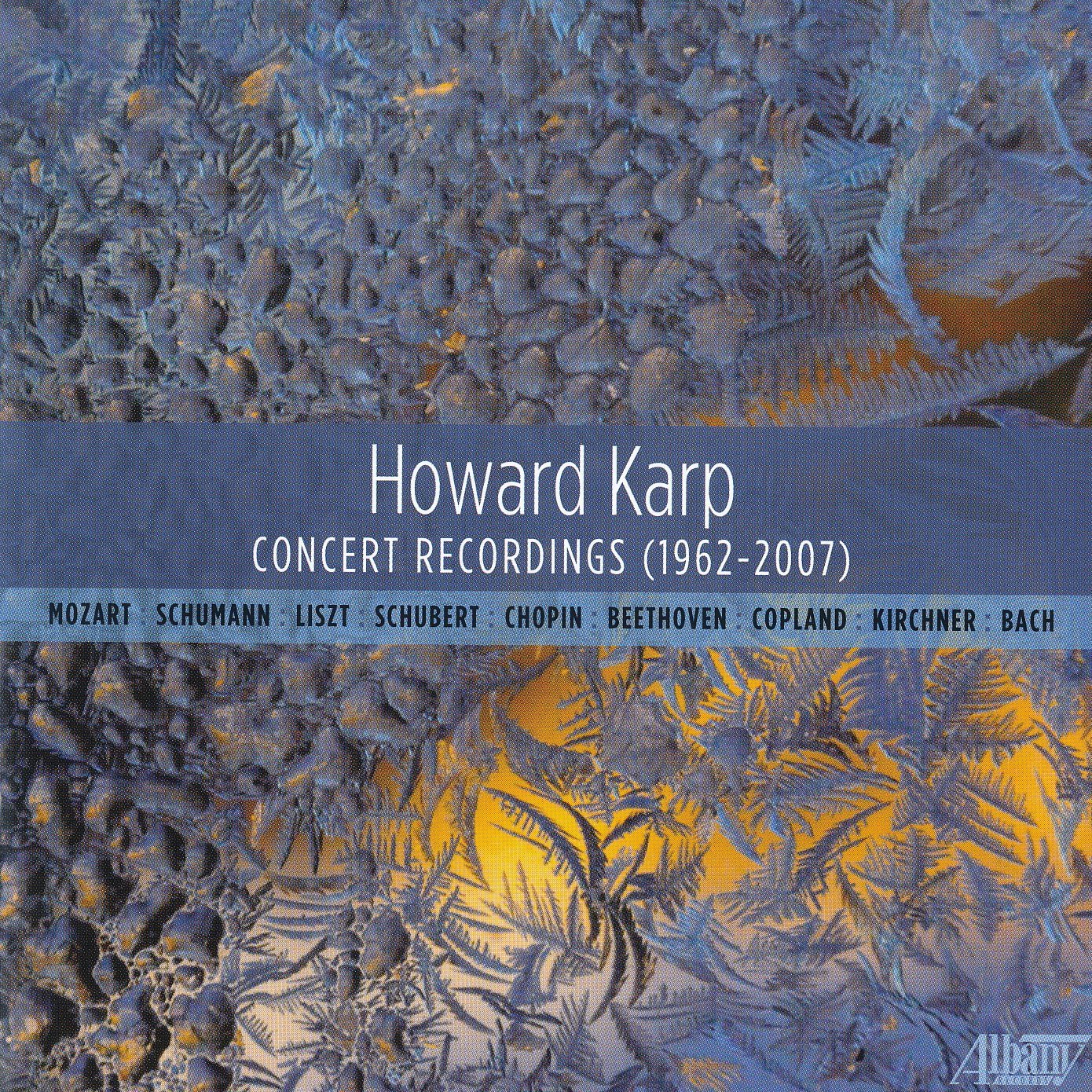Notes I wrote for the 6 CD Albany Records collection of live performances by the great American pianist, Howard Karp. These are proper live recordings – taken mostly from archival reel-to-reel 2 track tapes of Howard’s concerts in Madison and Urbana. Give his Beethoven a listen!
 Many pianophiles will have read that Beethoven’s Hammerklavier (a German synonym for “pianoforte”) Sonata was inspired by the gift of a great Broadwood piano, an instrument whose revolutionary possibilities so excited Beethoven that he composed most of the work while the piano was actually in transit from London. Stirred into action by the idea of the new instrument, Beethoven had set to work on a sonata that would put to full use its entire extended keyboard and expanded dynamic range.
Many pianophiles will have read that Beethoven’s Hammerklavier (a German synonym for “pianoforte”) Sonata was inspired by the gift of a great Broadwood piano, an instrument whose revolutionary possibilities so excited Beethoven that he composed most of the work while the piano was actually in transit from London. Stirred into action by the idea of the new instrument, Beethoven had set to work on a sonata that would put to full use its entire extended keyboard and expanded dynamic range.
Howard Karp had long subscribed to this received wisdom, until he made an interesting discovery while travelling. “During a sabbatical year from the University of Illinois in 1968-69 in Vienna— I spent a few days in Budapest, and I knew that Beethoven’s Broadwood piano, the instrument for which I believed he wrote his Hammerklavier Sonata, was on display at the National Museum in that city. Knowing that the work had an extended range of 6 1/2 octaves, from the lowest C to the highest F on the modern Steinway, I found, to my amazement, that the instrument had a range of just 6 octaves, from the lowest C to the second highest C. That meant that the first and second movements were written for a different instrument in Vienna. The Broadwood, which was sent to him in Mödling as a gift in the spring of 1818, was used only when he wrote the final two movements.”
Beethoven’s compositional output between 1800 and 1810 is astonishing in both its quality and its quantity. The year 1806 alone yielded the Violin Concerto, the Fourth Piano Concerto, the Fourth Symphony and the three Razumovsky quartets. By 1812, the year of the Seventh and Eighth Symphonies, new works were coming more infrequently and only as the result of ever-greater struggles, and by 1813, Beethoven seems to have entered a period of personal and artistic crisis. Even as he was writing this new sonata in 1817 in a long-awaited burst of new creative energy, he confided to his friend the cellist Nikolaus Zmeskall von Domanovecz that “as far as I am concerned, I am often in despair and want to end my life. God have mercy on me, I consider myself as good as lost.”
As he struggled with family and financial difficulties, Beethoven was also pushing himself to rethink his entire approach to musical form, an approach that had remained remarkably consistent throughout the previous decade’s work. As he reached toward what would finally emerge as his “late” style” we can see how, from the opus 95 String Quartet in f minor (Serioso) to the final two Cello Sonatas, opus 102, Beethoven is forcibly challenging and discarding many of the formal processes that had served him so well in the previous decade, experimenting with new ideas and finally searching out, with some difficulty, a new, more flexible approach to sonata form that incorporates a much greater and more original use of fugue and variation technique.
Opus 106 shows Beethoven emerging from this period of intense artistic self-examination with renewed confidence. Although it was to be the longest of all of Beethoven’s sonatas, the sheer scale of the work is not in itself new. “Beethoven’s scale, time and structure are difficult to pin down,” says Howard Karp. “His early sonatas, beginning with opus 2, are not just a continuation of the scale of Haydn or Mozart. They are more symphonic in scope, and all are in 4 movements. Opus 7 is possibly second in length to the Hammerklavier. Opus 106 is so huge because of the extended slow movement and the mammoth fugue, with its lengthy introduction. The last 5 sonatas are so contrasting in the use of variations and/or fugues.”
The Hammerklavier is also remarkable for the way in which the entire vast form is governed to a remarkable degree by the constructive possibilities of a single musical interval— the third. Beethoven uses the third as a cantus firmus, exploiting it as the fundamental building block of not only most of the melodic ideas, but also as the spine of the fugue subject and the finale, and, perhaps most originally, he uses it to inform the large-scale tonal scheme of the piece. Amazingly for a work of this time, the most important harmonic changes in this Sonata are not shifts from tonic to dominant and back, but shifts up or down a third.
Just as the Hammerklavier shows Beethoven finding a new level of rigor in his approach to form, it also shows him being even more exacting in his demands on performers. In fact, this work was the only one of Beethoven’s 32 piano sonatas for which the composer provided metronome markings, and they are very fast. “One cannot play the Beethoven metronome markings in opus 106 without taking some chances,” says Howard Karp. “Perhaps taking chances is part of playing Beethoven in general. The first time I heard the Hammerklavier in a public recital was in my senior year at Oberlin College when Rudolf Serkin included it in a solo recital. The entire recital was overwhelming and the Beethoven was a colossal performance— the fast seemed so fast and the slow so slow. Many years later I heard him play the work again in his last recital at the University of Wisconsin. It was less extreme than in 1951 in both slow and fast tempi. I much preferred the memory, at least, of the earlier performance.”
In addition to his studies at Oberlin and Juilliard, Karp highlights the lasting importance of a memorable encounter with one of the 20th century’s great Beethovenians. “I had the enormous honor and pleasure of attending Wilhelm Kempff’s two week Master Classes at his home in Positano, Italy in the late spring of 1969. In order to be there, along with 5 other pianists, one had to have 6 sonatas and 2 concerti at “concert pitch.” I felt I was in the presence of a true master musician and great pianist. We went through 30 sonatas, excepting only the two of opus 49. We would play, in chronological order, the solo sonatas; Kempff would comment and illustrate, and then play the entire work through. His playing was so inspiring, spiritual and moving— technique impeccable at age 74. Then we did the same with the concerti, accompanied by Mr. Kempff. Everything he played, whether solo or accompaniment was by memory. It was two weeks of heaven!”
Although Beethoven’s health problems would continue to disrupt progress towards finishing the pieces he felt destined to write in his last years, after the completion of the Hammerklavier, Beethoven no longer seemed in doubt about what those pieces were meant to be. In 1819, publisher Moritz Schlesinger asked Beethoven for some songs and three new piano sonatas, and, after he reluctantly agreed to Beethoven’s demands to maintain publication rights in the United Kingdom, the composer set to work on his final triptych of sonatas, which in many respects seem to have been conceived and created in a single breath. In fact, an attack of jaundice in 1820 necessitated a break between opus 109 and the last two sonatas. Beethoven is remarkably consistent throughout his output in the moods he seems to associate with certain keys, and certainly the c minor of opus 111 is very much the same stormy and tragic key heard in works like the Fifth Symphony, the Pathetique Sonata and even his Piano Trio opus 1 no. 3. For Beethoven, c minor was not just a key— it was a problem. The Fifth Symphony suggests a solution to the “problem” of c minor in the triumphant C Major song of victory that makes up its Finale. While the c minor of opus 111 is not far from that of the Fifth (in fact, Beethoven marks them both Allegro con brio, albeit adding ed appassionato in opus 111), the C Major the final movement of opus 111 comes from a more rarified and exalted place than the C Major of the Fifth— it is a song of thanksgiving rather than a celebration of victory. Pianist Andras Schiff calls this movement “the most spiritual creation of the most spiritual composer.”
This disc concludes with a movement from a sonata Karp had a special affinity for, performed on the same concert as the Hammerklavier. The all-Beethoven format was an exception for Karp rather than the rule of his recital programming. “Most of my public playing consisted of programs of more than one composer. Usually, when playing compositions of one composer, it was because of celebrating a “round number”, birth year, or commemorating a death year.” This Beethoven disc comes from the birth year commemorations of 1970. Karp’s passion for this early masterpiece began during his undergraduate days. “My wonderful Oberlin teacher, Jack Radunsky, kept me on Beethoven’s opus 2 #2 for two years. I learned so much from him, a born teacher.”

Recent Comments